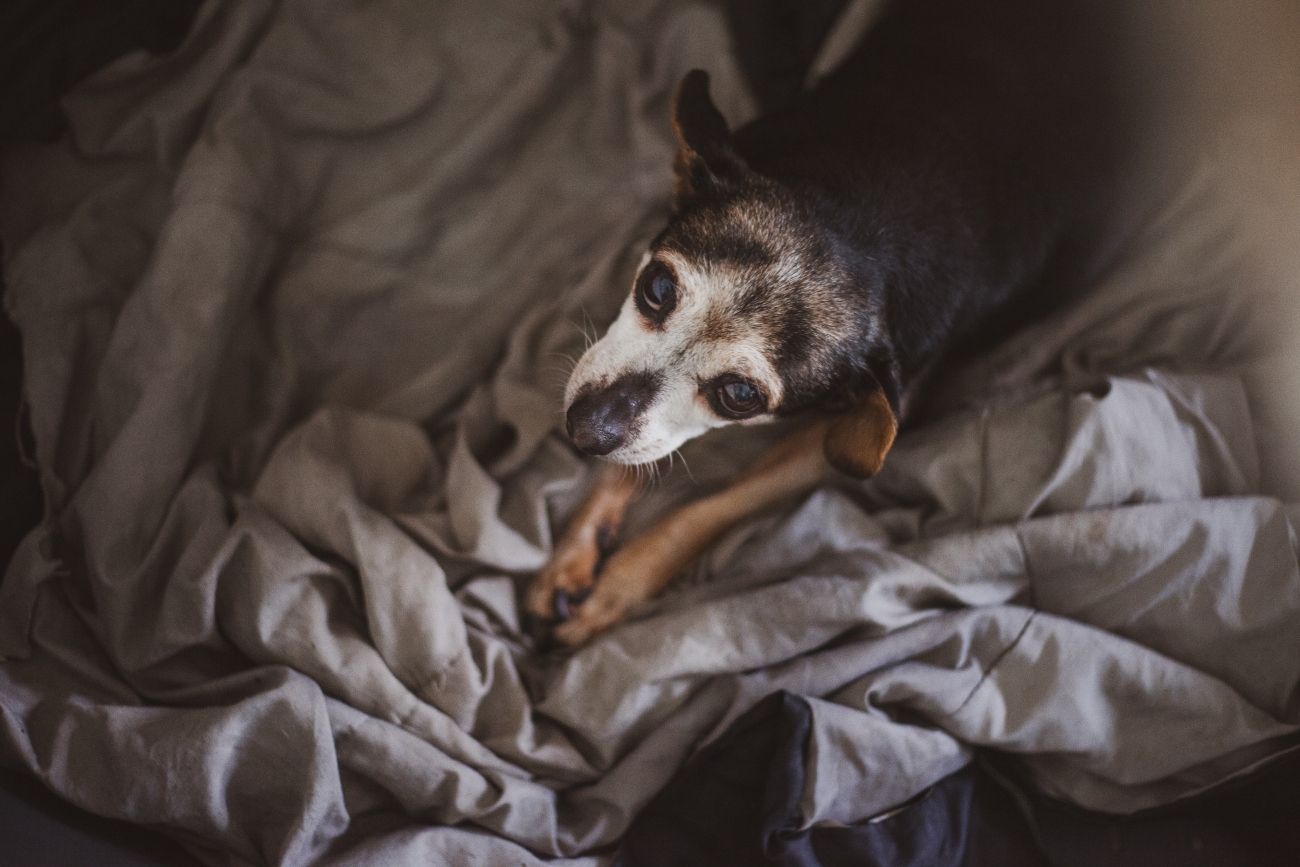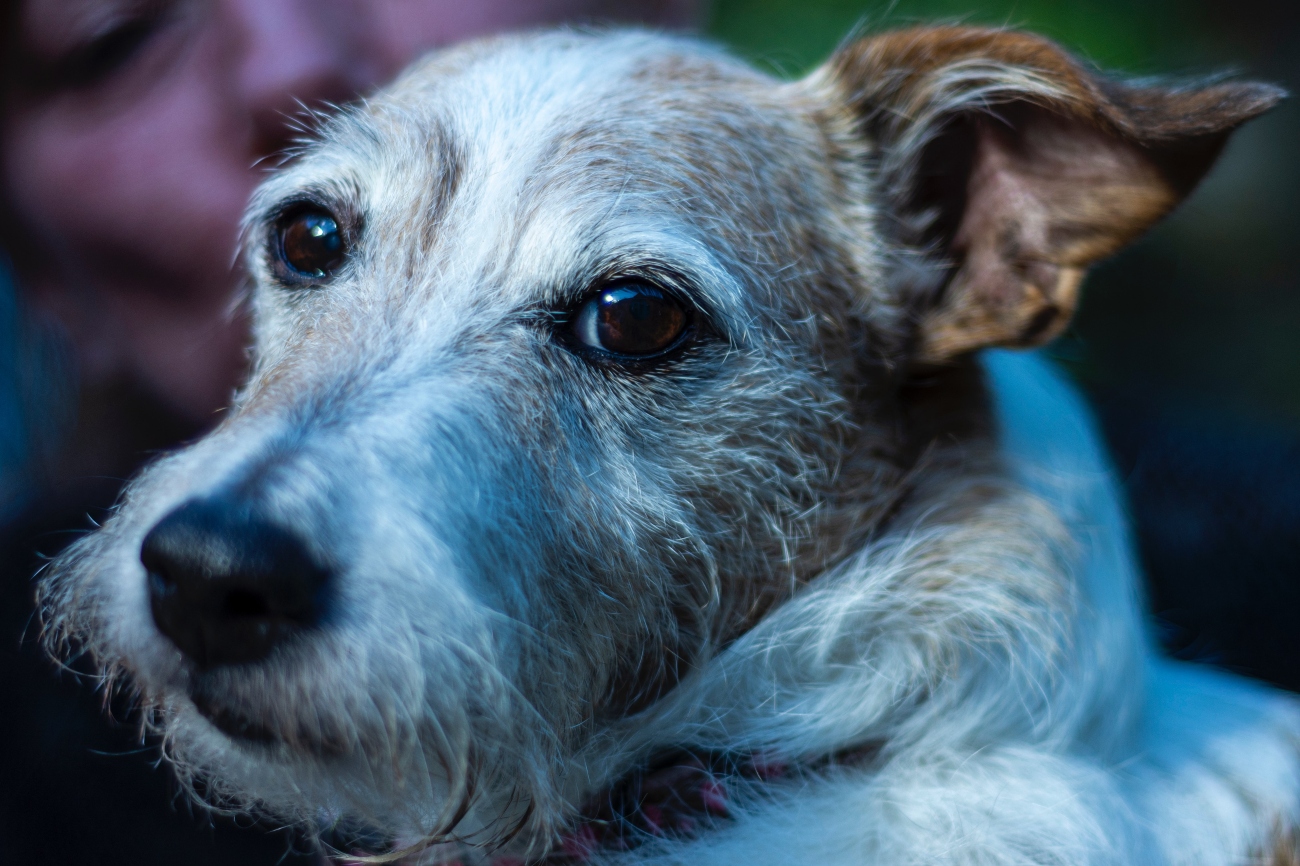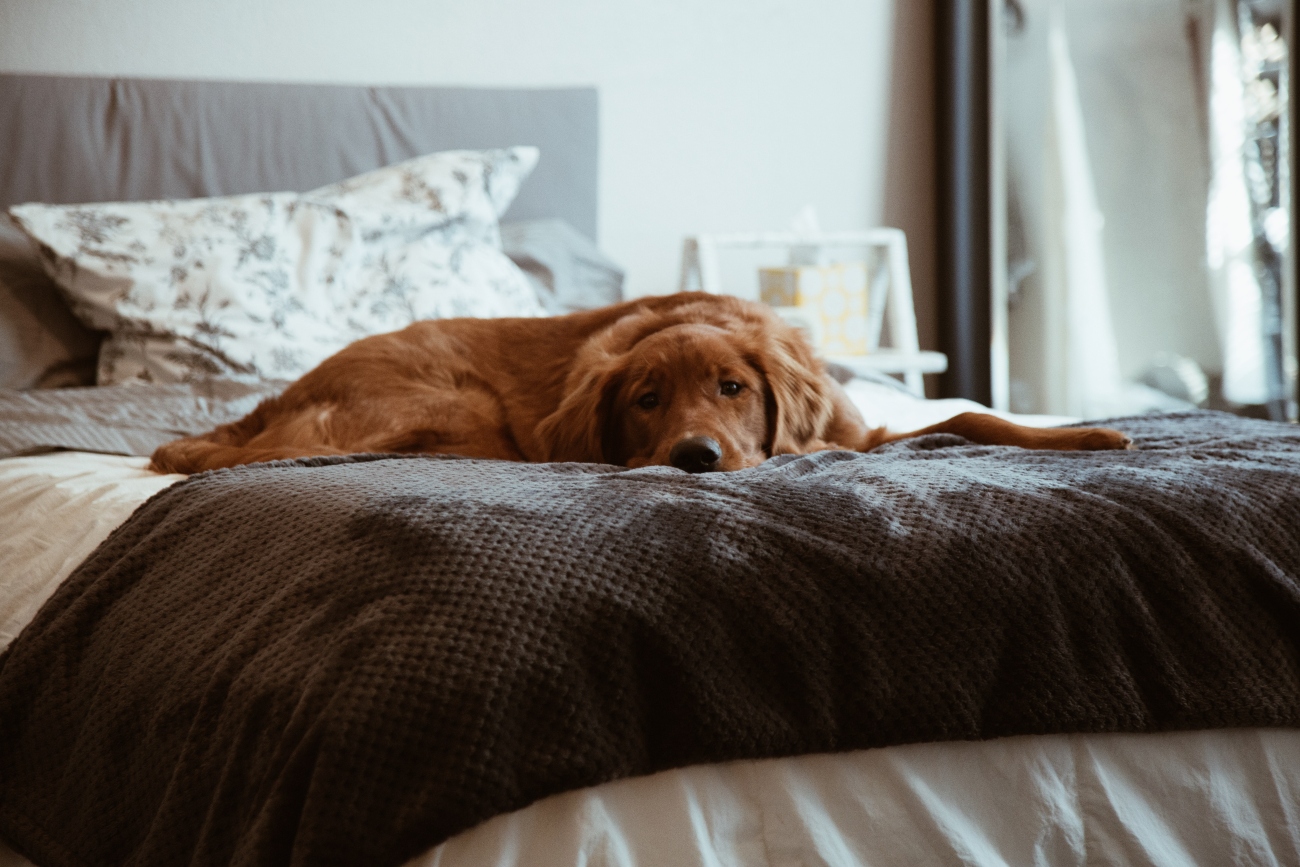
Why have my old dog’s hind legs collapsed?
21st January, 2022
As the owner of a senior dog, there are few more upsetting sights than seeing their hind legs collapse.
Hind leg weakness generally worsens over time, so you might not notice the changes first. In other more serious conditions it can happen quite suddenly, making it all the more shocking.
Here at Petwise, we understand that caring for a senior dog is a big responsibility. Perhaps they’ve been with you from a pup? Or perhaps you’ve adopted a senior dog later in its life? With Petwise, there’s no upper joining age limit so whether your dog is seven or 17, we can help you find the right cover for them.
Let’s look now at hind leg weakness in dogs. What causes it, what the symptoms are and how you can help make your senior dog’s life more comfortable if it happens to them.

What are the symptoms of hind leg weakness?
Have you noticed your old dog wobbling when they get up from their bed? You might have shrugged it off as stiffness or general old age, but there could be more to it than that.
Here are some of the common signs that your dog is experiencing hind leg weakness:
- Stumbling
- Reluctance to jump up onto the sofa or into the car
- Weak, wobbly legs
- Involuntary kicking of hind legs
- Taking smaller steps with their hind legs
- Worn down toenails on the hind feet
- Full collapse
In more severe cases, the wobbliness could be accompanied by incontinence - both urinary and faecal. If this is the case, it’s best to get your dog checked at the vet as soon as possible. You can also call the 24-Hour Vet Helpline if you’re with Petwise - just one of the benefits of having pet insurance for older dogs through us.
What’s causing my dog’s hind legs to give way?
There could be several possible reasons for your old dog’s hind leg weakness. Let’s look at some of them in more detail now and the possible treatments for each one.
Arthritis
Just like us humans, dogs can start to experience arthritis as they get older. As bones get used, the joint fluid and cartilage surrounding them get worn away. The bones then rub against each other causing the joints to become swollen and painful.
Many popular family breeds can be affected by arthritis including Labradors, Springer Spaniels, Golden Retrievers, Rottweilers and German Shepherds.
In fact, when it comes to Labs, it’s just one of the many conditions they can suffer from in later life, as we’ve discovered elsewhere on our blog.
It’s important to remember that dogs can develop arthritis as part of the normal aging process. That’s why, as a caring owner, you need to know what’s normal behaviour for your dog so you can spot the signs that something might be wrong.
Symptoms to look out for include:
- Limping
- Stiffness
- Narrow hips and back end due to weak muscles
- Swollen joints
- Reluctance to walk or jump as before
So how can you help relieve the symptoms? Anti-inflammatory drugs are usually the first port of call to deal with any pain. Some vets may also prescribe joint supplements and gentle swimming sessions to help your dog exercise without putting extra strain on their joints.
Obesity will make the condition even worse so do all you can to keep your dog at a healthy weight. Our pet insurance for older dogs can help towards the cost of any special diets - ask for more details when you get a quote.
Surgery can also be an option in some cases - talk it through with your vet to see what the best course of action is for your dog and the quality of life they’re likely to have afterwards.
Degenerative myelopathy
Degenerative myelopathy affects the nerves in the lower spine and, as the name suggests, gradually gets worse over time. You cannot cure this condition, so treatment focuses on keeping your old dog as pain-free and as comfortable as possible.
As the PDSA explains, some breeds are more prone to degenerative myelopathy than others. If you have an old German Shepherd, Boxer, Corgi or Bernese Mountain Dog, you should definitely be on the lookout for hind leg weakness when they get to around nine years of age. Pugs, Poodles and Collies can also be affected by this condition.
Symptoms can include paralysis of the back legs, and incontinence. If this is something you’re dealing with right now, we’ve got some top tips on older dog incontinence elsewhere on our blog.
What can you do to help? Light exercise and foot protection like doggy boots will help protect their paws and nails. Always consult your vet to check your current exercise regime is right for your dog. Too little and they risk gaining weight; too much and they may aggravate their condition even further.
Physiotherapy and hydrotherapy could also help a dog with degenerative myelopathy. We have listed a few training activities for older dogs in a recent blog but do check with your vet to see what’s appropriate for your canine.
If you take out pet insurance for older dogs through Petwise, you’ll also have access to a 24-Hour Vet Helpline, so you can get answers to your questions from a veterinary professional day or night.
This painful condition can start to affect your dog’s quality of life, so you need to think carefully about when it’s time to say goodbye. Our bereavement helpline can also help you through this difficult time.
In order to diagnose degenerative myelopathy correctly, your vet may carry out a mixture of physical exams, blood tests, X-rays or MRIs. Many of the characteristics are similar to arthritis, so it could take a while to diagnose. All of these tests can be expensive. Pet insurance for older dogs can help you meet these costs and get your beloved friend the help they need.

Intervertebral disc disease (IVDD)
If you’ve ever slipped a disc, or had any type of severe back ache, you’ll know how utterly painful and debilitating it can be. Sadly, our older dogs can also suffer a similar condition.
IVDD or intervertebral disc disease occurs when the spongy cushions between the discs in the back become hard and fragile. Slipped discs can move and crush the spinal cord causing nerve damage and, in some cases, paralysis and incontinence.
Back damage can also occur from trauma if your dog has an accident, but usually, IVDD is the most common cause of slipped discs in dogs.
It can come on very quickly, or develop over time. That’s why you need to spend quality time with your dog, and understand their normal behaviour so you know when something has changed.
You may have heard of this condition affecting Dachshunds in particular due to their long, sausage-like backs. But it’s also been seen in French Bulldogs, Basset Hounds, Beagles, German Shepherds and Shih Tzus.
What are the symptoms? Look for the following things that could indicate a slipped disc:
- Back pain and avoiding being touched on the back
- Problems getting up
- Wobbly legs or scuffing when they walk
- Paralysis
Your dog may also pant more if they are in pain, so look out for this subtle sign, too. Check out our blog on heavy panting in older dogs for some more possible causes.
Moving a dog with a slipped disc can be very difficult as you don’t want to make the problem worse. The PDSA advises that you should move them on a board if you can to keep the back supported. They also remind us that, whether they’re young or old, all dogs in pain might try to snap or bite, so be careful you don’t get hurt.
Your vet will need to carry out special imaging like X-rays and MRI scans in order to properly diagnose a slipped disc. This may require your dog to have an anaesthetic. The Animal Trust has a great guide on how to care for your dog after surgery.
There are three possible routes for treatment in the case of a slipped disc - pain relief and physiotherapy; surgery; or possibly putting your old dog to sleep. Discuss the options with your vet and work out the right course of action for your dog.
Often, if the dog can no longer walk, or is in large amounts of pain every day, it’s kinder to put them to sleep. Our pet insurance for senior dogs includes farewell cover should it come to that.
Hopefully, they will be able to return to you fit and well after surgery. If they do, it’s really important to limit the likelihood of them slipping over again and causing more damage. If you have wooden floors at home, you may wish to put down rugs to give them more grip.
Also remember that their normal cleaning routine may become more painful, so you may have to give them a helping hand with that. And keeping their weight at a normal level will help prevent any further strain on the joints. Check with your vet what type of exercise might be appropriate.
What else could it be?
When your older dog gets sick, their ability to walk can be affected, even if there is nothing actually wrong with the legs or joints themselves.
Other health conditions that can lead to a more generalised weakness in your older dog can include things like:
- Anemia
When the dog doesn't produce enough haemoglobin or red blood cells. - Diabetes
An incurable disease when the dog stops producing insulin. Read our recent blog on what the signs of diabetes are in older dogs. - Cancer
This could be cancer of the bone or elsewhere in the body. - Kidney disease
When the kidneys and renal system start to fail. - Liver disease
When the liver no longer removes toxins from the system. - Tick paralysis
Paralysis can be caused by a toxin in the tick’s saliva. - Spinal stroke
When a piece of disc breaks away and blocks blood flow to the spinal cord, your dog can suffer a spinal stroke. - Poisoning
From antifreeze to chocolate to the liquid in e-cigarettes, there are many potential doggy poisons around our homes.
Don’t assume your dog’s walking problems are just old age. Make sure you take them for regular check-ups and call our helpline if you spot a new health issue you’re not sure about.

Has your dog been injured?
We’ve discussed many painful conditions in this article - some common, some not so common - but sometimes hind leg weakness in dogs can be caused by something as simple as an injury.
Your dog might have landed badly after jumping out of the car or playing in the park, or simply overdone it on their daily walk. Perhaps they’ve been bitten by another animal? Or cut their paw on a piece of broken glass?
Sprains, strains and injuries can make your dog limp or suddenly lose the use of their hind legs. Again, a vet may need to take crucial MRI scans or X-rays in order to see what’s going on if the injury isn’t immediately obvious.
It goes without saying that any injury should be checked by a vet as soon as possible. Having pet insurance for older dogs in place will mean you won’t hesitate to get your canine the help they need.
Pet insurance for older dogs
We all want our older dogs to enjoy life for as long as possible. And that means being able to walk, run, jump, climb and even curl up on their beds like they’ve always done. Back and hind leg problems can impact on their quality of life - but just because they’re getting on in years, that doesn’t mean it’s the end.
At Petwise, we have no upper joining age limit so even if you welcome a dog into your home in their later years, we can still help you provide the care they need.
Benefits of our specialist senior pet insurance can include:
- Dental cover as standard
- 24-Hour Vet Helpline
- Senior food contribution
- UK-based call centre team
Get a quick quote today and protect your faithful friend for life.